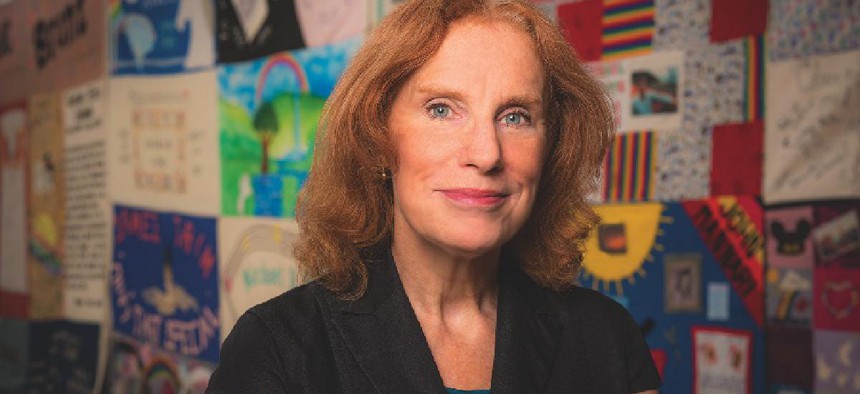
Sam Kittner/Kittner.com
The Fed Who Took a Risk and Saved Lives
How Dr. Lynn Mofenson virtually eliminated HIV transmissions between mother and child.
Working with the Partnership for Public Service, we have the privilege of profiling the 2012 Samuel J. Heyman Service to America Medals (a.k.a. the SAMMIES) winners over the next several weeks. We will not only tell their incredible stories of determination and, in many cases, life-changing achievements – but we’ll also be pulling out key leadership and management tips with a few lessons learned that can be modeled across agencies.
The top medal, Federal Employee of the Year, was presented to Lynne Mofenson, branch chief, Adolescent and Maternal AIDS Branch at the National Institutes of Health in Rockville, Maryland. Lynne’s is a story of incredible innovation that challenged conventional wisdom and championed controversial methods that have since saved hundreds of thousands of lives.
I believe, at the heart of it, Lynne’s achievement is a premier example of taking a calculated risk – in a federal government that is often quite averse to the notion. The anti-AIDS drug, zidovudine, or AZT, which Lynne gave to pregnant mothers as part of a carefully-designed trial to eliminate HIV transmission, was highly controversial and feared dangerous. Luckily for Lynne, NIH has created an environment that is dependent on innovation and fearless collaboration.
So, I ask you – does your organization challenge you to innovate and take risks? Do you create an environment that allows your staff, or colleagues, to push the boundaries of conventional wisdom for the benefit of achieving your mission? At Excellence in Government Live on September 6th, Elizabeth McGrath, Deputy Chief Management Officer at the Department of Defense, said in a keynote address, “If you have the opportunity to make a difference, you have the responsibility to do so.”
Lynne took that responsibility seriously. Read her story…
Conquering Childhood AIDS
By The Partnership for Public Service
Creating an AIDS-free generation worldwide has become a national goal in no small part because of Dr. Lynn Mofenson’s seminal work that has helped virtually eliminate the transmission of HIV from mother to child in the United States.
When Mofenson came to the National Institutes of Health (NIH) in 1989, there were over 2,000 new U.S. pediatric AIDS cases a year. Today, this number is now less than 100 per year.
Critical to halting this horrible epidemic was Mofenson’s role in designing and conducting a bold and controversial clinical study that used the only available anti-AIDS drug, zidovudine, or AZT, to prevent pregnant mothers from passing the HIV virus to their babies. At the time, no one had thought of using this drug for this purpose.
To Mofenson, launching the controversial study was “a no brainer.”
“It was a horrible disease, killing mothers and babies. We had to do something,” she said.
The clinical trial demonstrated a two-thirds reduction in the risk of HIV transmission from mother to child, down from 25 percent to 8 percent. It turned the tide on pediatric AIDS. “We were quite amazed that it worked so well,” Mofenson said.
The clinical trial was the beginning of a long-term collaboration among researchers—called the Pediatric AIDS Clinical Trials Group—that conducted a series of successful studies to identify and optimize strategies to block mother-to-child transmission of HIV, the primary way children become infected.
“Lynne has been the preeminent scientific leader in the prevention of AIDS in children in the world,” said Dr. R.J. Simonds, a vice president at the Elizabeth Glaser Pediatric AIDS Foundation. Many people have contributed to AIDS research, but Simonds said Mofenson’s work provided clear direction and speed.
“She moved the field along uniquely because of her command of scientific issues,” he said. “Her credibility and knowledge base are unparalleled.”
Mofenson has since dedicated her career to conducting additional research and influencing national policy in the field.
She has been deeply involved in formulating recommendations on pediatric AIDS prevention, and serves as a leader in research and policy on the world stage, expanding the clinical trials network to developing countries in Africa and elsewhere. Through U.S. programming and funding to other countries, it is estimated that 200,000 infant HIV infections were prevented last year alone.
“Her mission is to wipe out pediatric AIDS,” said Dr. Sten Vermund, director of the Institute for Global Health at the Vanderbilt University School of Medicine. “She really wants to make a difference for moms and kids, first in the U.S. and now in the developing world,” he said.
This is the first in a series of profiles featuring the recipients of the 2012 Samuel J. Heyman Service to America Medals. Presented to outstanding public servants by the nonprofit Partnership for Public Service, and sponsored in part by Bloomberg, Booz Allen Hamilton, The Boston Consulting Group, Chevron and United Technologies Corporation, the prestigious Sammies awards are offered in nine categories. To nominate a federal employee for a 2013 medal go to servicetoamericamedals.org.
Want more Excellence in Government? Follow us on Twitter | Facebook | Google + | LinkedIn






